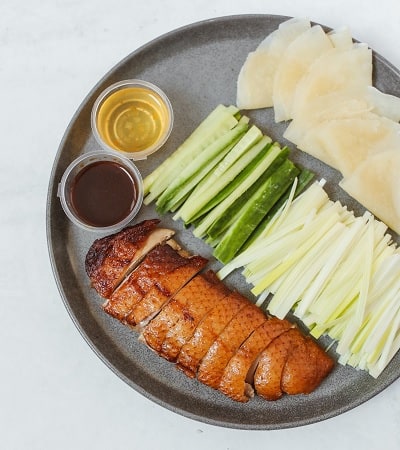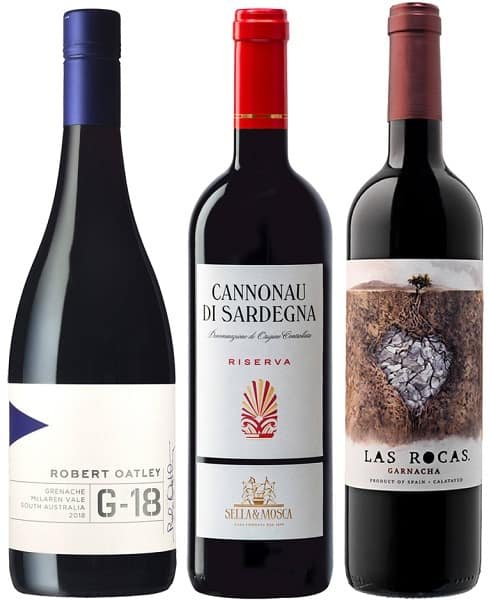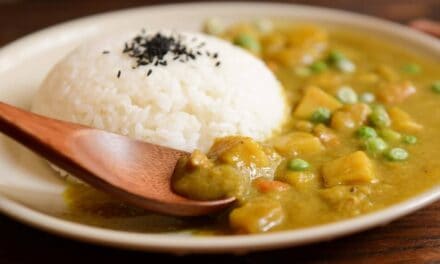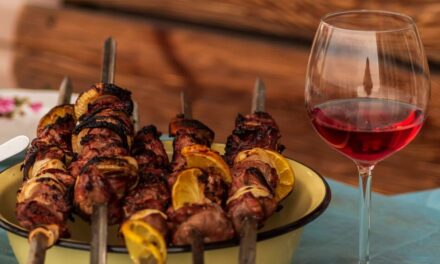Chinese cuisine is loved worldwide for its exotic flavors and because many meals are pretty easy to cook. What is not so easy is pairing Chinese food and wine. Nevertheless, it is possible, and with the right wine, your dinner will be even better. In this article, we will discuss the best combinations of wine and Chinese food.
White wine is the right match for most Chinese dishes. Only bold meals with very intense flavors pair well with red wines. In any case, you need a low-tannin wine with a good acidity level.
To better understand how to pair Chinese food and wine, we will discuss these specific pairings:
- Chow Mein and Wine
- Shrimp Fried Rice and Wine
- Peking Duck and Wine
- Szechuan Chicken and Wine
- Spring Rolls and Wine
- Chicken Sweet and Sour and Wine
- Kung Pao Chicken and Wine
But first, let us elaborate on the general rules for pairing wine and Chinese food in more detail.
HOW TO PAIR CHINESE FOOD AND WINE
Chinese food is incredibly flavorful, and it is not unusual for a single dish to combine a wide variety of aromas. For wine lovers, these flavor profiles create a problem, though. Finding the right wine for a meal that complex can be difficult. With the following rules, you can narrow down the perfect combination of Chinese food and wine:
- Typically, Chinese food is relatively light and thus an excellent match for white wines. Red wines only work with a few bolder dishes that feature ingredients with intense intrinsic flavors. That is true, for instance, for duck dishes. In any case, you should avoid bold reds.
- High-tannin wines clash with acidic meals. As many meals showcase sour notes, you should better go for low-tannin wines. Otherwise, your Chinese food and wine pairing will be unbalanced.
- Many dishes feature a wide variety of flavors, ranging from sweet to sour to salty to spicy. These meals work best with well-balanced wines that offer subtle sweetness.
- Meats like chicken or pork are often fried (and sometimes breaded) in Chinese cuisine. If that is the case, you need high acidity in your wine so that it can stand up to the meat.
- Very spicy meals are great with sparkling wines because the bubbles help clean the palate and reduce the heat.
With these rules in mind, let us talk about some of the most popular Chinese food and wine pairings.
Chow Mein and Wine
Chow Mein might be one of the most simple Chinese dishes. Actually, it is not an original Chinese dish but an American adaptation. The original is called “Chaomiàn” and is made from soft noodles and several vegetables. In many cases, it comes with some type of protein, such as chicken or tofu. The U.S. variation called Chow Mein is typically made from stir-fried pasta that is more crunchy than soft Chinese noodles.
Although the ingredients typically are lean and light, the frying makes Chow Mein an oily dish. It can be hot or mild, depending on the spices used to season it. You can also expect salty notes from soy sauce.
An aromatic white wine is the right wine pairing for Chow Mein. It should have a good level of acidity to cut through the oily noodles. Think of a Sauvignon Blanc from New Zealand or Australia.
Shaw + Smith Sauvignon Blanc 2021
- type: white, still, Vintage
- origin: Australia, South Australia
- varietal: Sauvignon Blanc
- alcohol: 12.0%
Hewitson LuLu Sauvignon Blanc 2020
- type: white, still, Vintage
- origin: Australia, South Australia
- varietal: Sauvignon Blanc
- alcohol: 12.0%
Berton Vineyards Metal Label Sauvignon Blanc 2021
- type: white, still, Vintage
- origin: Australia, South Australia
- varietal: Sauvignon Blanc
- alcohol: 12.7%
Sparkling wine lovers can enjoy their Chow Mein with Prosecco. Especially if the dish is very spicy, the sparkler’s bubbles are great for balancing flavors. Here are some bottles to try:
- type: white, sparkling
- origin: Veneto, Italy
- varietal: Glera
- alcohol: 11.0%
- type: white, sparkling
- origin: Veneto, Italy
- varietal: Glera
- alcohol: 11.0%
Fantinel One and Only Prosecco Brut 2017
- type: white, sparkling, Vintage
- origin: Friuli-Venezia Giulia, Italy
- varietal: Glera
- alcohol: 12.0%
Shrimp Fried Rice and Wine
Fried rice undergoes a similar cooking process as Chow Mein. The rice and various vegetables such as cabbage, carrots, and peas are egg-fried and seasoned with soy sauce and several spices like ginger or chili. Fried shrimps add crunchiness to the meal.
The final dish is salty, spicy, and crunchy, with various aromas from the vegetables. A great wine to accompany these flavors is Gewürztraminer. In particular, the dry and off-dry styles from the Alsace region in France are good choices. They add delicious notes of tropical fruits and spices to the flavor mix. Here is a selection of bottles:
- type: white, still, Vintage
- origin: Alsace, France
- varietal: Gewürztraminer
- alcohol: 14.0%
Zind-Humbrecht Gewürztraminer 2019
- type: white, still, Vintage
- origin: Alsace, France
- varietal: Gewürztraminer
- alcohol: 14.0%
Albert Boxler Gewürztraminer Reserve 2018
- type: white, still, Vintage
- origin: Alsace, France
- varietal: Gewürztraminer
- alcohol: 14.0%
Peking Duck and Wine
When talking about Chinese food, Peking Duck is one of the first dishes that comes to mind. The Chinese have known the recipe for more than 700 years, making it one of the oldest meals of their cuisine.
Duck breast is an essential ingredient. It gets cooked until its skin is golden-colored and crispy. Typical side dishes are steamed spring pancakes and various vegetables to fill them, and at least one of two sauces: Salty hoisin sauce or fruity plum sauce.
Combine this iconic Chinese food and wine that is not too bold. A medium-bodied red with a low tannin level is fine; bolder wines could overpower the meal. French Pinot Noir or Garnacha wines have the right characteristics. Their red fruit flavors are superb with the crispy duck meat. They also match both the hoisin and the plum sauce that give Peking Duck its typical taste.
If you prefer white wine, you should try a ripe but unoaked Chardonnay with tropical aromas. French wines, for instance, from Burgundy are great picks.

Peking Duck with Spring Pancakes, Vegetables, and Sauces
Joseph Drouhin Laforet Pinot Noir 2019
- type: red, still, Vintage
- origin: France, Burgundy
- varietal: Pinot Noir
- alcohol: 12.5%
Remoissenet Beaune Teurons Premier Cru 2019
- type: red, still, Vintage
- origin: France, Burgundy
- varietal: Pinot Noir
- alcohol: 14.0%
Domaine Comte Georges de Vogue Bonnes-Mares Grand Cru 2018
- type: red, still, Vintage
- origin: France, Burgundy
- varietal: Pinot Noir
- alcohol: 13.0%

World of Grenache Tasting Trio
$44.99
from: Wine.com
Joseph Drouhin Macon Villages 2019
- type: white, still, Vintage
- origin: Burgundy, France
- varietal: Chardonnay
- alcohol: 13.0%
Bouchard Pere & Fils Meursault (Domaine) 2017
- type: white, still, Vintage
- origin: Burgundy, France
- varietal: Chardonnay
- alcohol: 13.5%
Domaine Leflaive Puligny-Montrachet Les Pucelles Premier Cru 2018
- type: white, still, Vintage
- origin: Burgundy, France
- varietal: Chardonnay
- alcohol: 13.0%
Szechuan Chicken and Wine
Another staple Chinese food is Szechuan Chicken. It comes from the Sichuan region in Southwest China. Its main ingredient is obviously chicken coated in cornstarch and pan-fried until it is golden and crisp. It goes together with vegetables such as onions, green and red bell peppers, carrots, or broccoli. Dried red chilis and Sichuan peppercorns give the dish an intense spicy heat. And a brown sauce made from hoisin sauce, sesame oil, and soy sauce adds salty and subtle sweet notes. Typically, Szechuan Chicken comes with steamed rice.
The dish features a wide variety of flavors, including sweet, salty, and spicy notes. An off-dry German Riesling is a great choice to stand up to this flavor profile. In particular, Spätlese wines are worth trying. Their sweetness is a great counterplayer for the chicken’s heat. And their mineral and fruity notes fit perfectly into the meal’s flavor profile.
Dr. Loosen Wehlener Sonnenuhr Riesling Spätlese 2019
- type: white, still, Vintage
- origin: Germany, Mosel
- varietal: Riesling
- alcohol: 8.5%
Schloss Vollrads Rheingau Riesling Spätlese 2016
- type: white, still, Vintage
- origin: Germany, Rheingau
- varietal: Riesling
- alcohol: 7.5%
J.J. Prum Graacher Himmelreich Riesling Kabinett 2020
- type: white, still, Vintage
- origin: Germany, Mosel
- varietal: Riesling
- alcohol: 9.0%
If you are not into sweet wines, go for a Gewürztraminer (see the pairings for Shrimp Fried Rice). It might be less effective in dealing with the spices, but its aromatic aromas are great add-ons to the meal.
Again, sparklers are even better at toning down the heat than still wines. Sweet Asti works as well as dry Champagne.
- type: white, sparkling
- origin: Piedmont, Italy
- varietal: Muscat
- alcohol: 5.0%
- type: white, sparkling
- origin: Piedmont, Italy
- varietal: Muscat
- alcohol: 7.5%
- type: white, sparkling
- origin: Piedmont, Italy
- varietal: Muscat
- alcohol: 7.5%
- type: white, sparkling
- origin: Champagne, France
- varietal: Chardonnay, Pinot Noir
- alcohol: 12.0%
- type: white, sparkling
- origin: Champagne, France
- varietal: Chardonnay, Pinot Noir, Pinot Meunier
- alcohol: 12.0%
- type: white, sparkling
- origin: Champagne, France
- varietal: Chardonnay, Pinot Noir, Pinot Meunier
- alcohol: 12.5%
Spring Rolls and Wine
Spring rolls are among the most iconic Chinese foods. These small, cylindrical pastries are filled with vegetables such as onions, carrots, cabbage, and soy sprouts. Optionally some chefs add meat. In addition, the rolls contain a sauce that is either sweet or savory. After pan-frying or deep-frying, they are very crispy yet light and delicate in taste.
Pair your spring rolls with a dry white wine such as Pinot Grigio or Grüner Veltliner. These wines are not too bold, so they will not overpower the spring rolls. Nevertheless, they have a good level of acidity to cut through the crispy pastry. Besides, their herbal notes complement the roll’s fresh ingredients deliciously.
Santa Margherita Pinot Grigio 2020
- type: white, still, dry, Vintage
- origin: Italy, Trentino-Alto Adige
- varietal: Pinot Gris
- alcohol: 12.5%
Tiefenbrunner Pinot Grigio 2019
- type: white, still, dry, Vintage
- origin: Italy, Trentino-Alto Adige
- varietal: Pinot Gris
- alcohol: 12.5%
- type: white, still, dry, Vintage
- origin: Italy, Friuli-Venezia Giulia
- varietal: Pinot Gris
- alcohol: 13.0%
Weingut Alzinger Steinertal Smaragd Grüner Veltliner 2019
- type: white, still, Vintage
- origin: Austria, Wachau
- varietal: Grüner Veltliner
- alcohol: 13.5%
Pratsch Organic Grüner Veltliner 2020
- type: white, still, Vintage
- origin: Austria, Niederösterreich
- varietal: Grüner Veltliner
- alcohol: 12.5%
Schloss Gobelsburg Schlosskellerei Gobelsburger Grüner Veltliner 2020
- type: white, still, Vintage
- origin: Austria, Kamptal
- varietal: Grüner Veltliner
- alcohol: 12.5%

Spring Rolls
If your spring rolls contain meat, you can enjoy them with red wine as well. Make sure the wine is not too heavy. Pinot Noir and Tempranillo wines are good choices, given they are unoaked.
Sparkling wine lovers can go for a Spanish Cava wine. The dry sparkler’s bubbles are excellent for cutting through the crispy dough and dealing with savory or spicy sauces. Check these out:
Freixenet Cordon Negro Cava Brut
- type: white, sparkling
- origin: Catalonia, Spain
- varietal: Macabeo, Parellada, Xarel·lo
- alcohol: 11.5%
Vins el Cep Kila Cava Brut 2018
- type: white, sparkling, Vintage
- origin: Catalonia, Spain
- varietal: Macabeo, Parellada, Xarel·lo
- alcohol: 12.0%
- type: rosé, sparkling
- origin: Catalonia, Spain
- varietal: Trepat
- alcohol: 11.5%
Chicken Sweet and Sour and Wine
The sweet and sour sauce is a delicious combination of various flavors. Sweet and sour chicken is the most common preparation, and often the chicken is breaded and fried. But you might also come across sweet and sour pork, meatballs, or seafood. In any case, the sauce is the exciting part of the dish. The ingredients that are responsible for its sweetness are sugar or syrup. In some cases, chefs also use sweet fruits like pineapples or plums to enhance the sweet notes. On the other hand, sourness comes from rice vinegar. Many sweet and sour sauces also feature salty notes from soy sauce or spiciness from chili or garlic.
The best wine pairing for sweet and sour dishes is a young white wine. It needs plenty of acidity to deal with the breaded meat. German Riesling is a safe choice. Make sure to pick a dry wine, though, for instance, from the Pfalz region:
Rebholz Von Rotliegenden Riesling Trocken 2020
- type: white, still, Vintage
- origin: Pfalz, Germany
- varietal: Riesling
- alcohol: 12.0%
Burklin-Wolf Pfalz Estate Riesling Trocken 2020
- type: white, still, Vintage
- origin: Pfalz, Germany
- varietal: Riesling
- alcohol: 12.0%
Von Winning Deidesheimer Paradiesgarten Riesling Erste Lage Trocken 2020
- type: white, still, Vintage
- origin: Pfalz, Germany
- varietal: Riesling
- alcohol: 12.0%
Chenin Blanc wine from the Vouvray appellation in France is another great match for sweet and sour chicken. In addition to their acidity, they often have notes of citrus and tropical fruits that complement the sauce perfectly. These wines are worth trying:
Domaine Huet Vouvray Sec Le Haut Lieu 2019
- type: white, still, Vintage
- origin: Loire, France
- varietal: Chenin Blanc
- alcohol: 13.0%
- type: white, still, Vintage
- origin: Loire, France
- varietal: Chenin Blanc
- alcohol: 13.0%
Domaine Huet Vouvray Le Mont Moelleux 2020
- type: white, still, Vintage
- origin: Loire, France
- varietal: Chenin Blanc
- alcohol: 13.0%
Kung Pao Chicken and Wine
Here is one more excellent Chinese chicken dish: Kung Pao chicken (also: Gong Bao). Like Szechuan chicken, the dish comes from Southwest China. Logically, the two meals share some similarities. The chicken breast is cut into cubes first and marinated with a mix of cornstarch, rice vinegar, and soy sauce. Then, the chef fries the chicken until it is golden-colored and crispy.
The sauce is what makes Kung Pao chicken unique. Made from soy sauce, hoisin sauce, sugar, and black vinegar, it combines sour, sweet, salty, and spicy aromas. In combination with peanuts, ginger, garlic, and vegetables like bell peppers, dried chilies, and onions, this sauce causes a flavor explosion in your mouth.
Unfortunately, this variety of aromas makes chicken Kung Pao challenging to match with wine. Nevertheless, you can match this complex Chinese food and wine. The best option is an off-dry Pinot Gris from Alsace. With its elegant sweetness, delicate fruit aromas, and high acidity, it gently balances the meal’s flavors.
Domaines Schlumberger Spiegel Grand Cru 2018
- type: white, still, sweet, Vintage
- origin: France, Alsace
- varietal: Pinot Gris
- alcohol: 13.5%
Albert Boxler Sommerberg Wibtal 2016
- type: white, still, off-dry, Vintage
- origin: France, Alsace
- varietal: Pinot Gris
- alcohol: 14.0%
- type: white, still, off-dry, Vintage
- origin: France, Alsace
- varietal: Pinot Gris
- alcohol: 13.5%
FINAL WORDS
While finding the proper wine for Chinese food is not easy, the right pairings are fantastic culinary experiences. With the details from this article, you are ready to find them. Which Chinese food and wine pairing will be your favorite?






